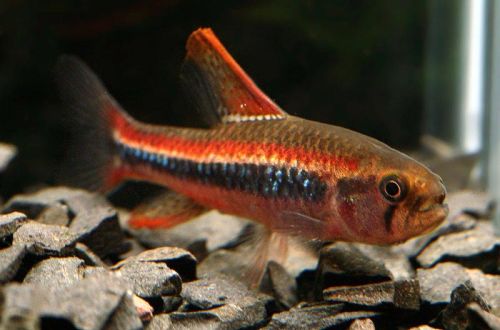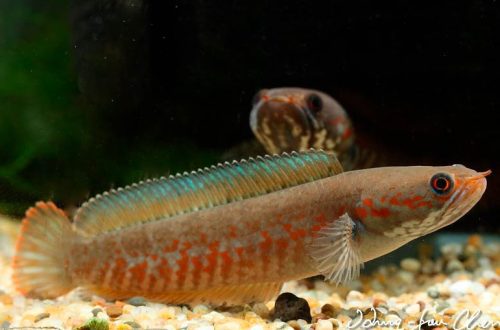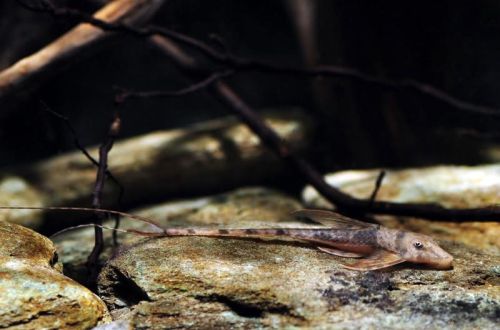
Black morpho tetra
The black morpho-tetra or Weizmann’s Pecilocharax, scientific name Poecilocharax weitzmani, belongs to the Crenuchidae family. A rare guest in home aquariums due to the high complexity of keeping. Not recommended for beginner aquarists.

Contents
Habitat
Comes from South America. It is found in several large river systems – Orinoco and Rio Negro, in Colombia, Venezuela, Guyana, the northern states of Brazil. Inhabits sluggish channels and streams flowing under the canopy of dense tropical forest. A typical biotope is a river with sand and silt substrates covered with a thick layer of fallen leaves with numerous snags. Due to the abundance of decaying plant organic matter, the water in this area acquires a rich brown hue. The shade of the trees and the dark water create an environment with rather dim lighting.
Brief information:
- The volume of the aquarium – from 40 liters.
- Temperature – 21-28°C
- Value pH — 3.0–6.5
- Water hardness – 0–5 dGH
- Substrate type – any
- Lighting – subdued
- Brackish water – no
- Water movement is weak
- The size of the fish is 4–5 cm.
- Nutrition – meat feed
- Temperament – conditionally peaceful, males are aggressive towards each other
- Keeping in a pair or by type of harem
Description
Adults reach a length of 4–5 cm. Males are larger and more colorful than females, and also have enlarged dorsal and anal fins. The coloration is gray-red with a wide black stripe stretching from head to tail. Translucent fins have a pattern of dark specks.
Food
Carnivorous look. In nature, it feeds on larvae of aquatic insects, small crustaceans and worms. In the home aquarium, an appropriate diet of live or frozen foods such as brine shrimp, daphnia, bloodworms, etc. should be offered.
Maintenance and care, arrangement of the aquarium
The optimal size of the aquarium for a pair of fish starts from 40-50 liters. Due to the peculiarities of behavior (more on this below), when keeping two or more males, it is necessary for each to provide a plot at the bottom of at least 30 cm x 30 cm. For ease of calculation, you can use the following ratio: 1 male – a tank of 40 liters, 2 males – plus another 40 liters, etc.
The design uses a soft sandy substrate, fine gravel, snags in the form of tree roots and branches, shade-loving plants, aquatic mosses or ferns are possible. From snags and plants create shelters.
It is recommended to add dried leaves of some trees to the aquarium, they serve as an excellent means of simulating natural conditions. In the process of decomposition, they saturate the water with tannins, which are part of the Black Morpho Tetra’s natural habitat, giving the water a characteristic brown tint along the way. Instead of leaves, special essences can be used. A few drops can replace a handful of leaves.
Fish are sensitive to the quality and hydrochemical composition of water. Favorable conditions are achieved in very acidic and soft water. Maintaining such low pH and dGH values will require the installation of a filter with filter media that acidifies the water, as well as a reverse osmosis system to soften it. It is important to carry out regular maintenance of the aquarium in order to avoid the accumulation of organic waste that can cause spikes in the concentrations of products of the nitrogen cycle (ammonia, nitrites, nitrates).
Behavior and Compatibility
Males are territorial and aggressive towards each other, with a lack of space, quite fierce skirmishes are inevitable. Females, on the contrary, are peaceful. In small tanks, only one male/female pair or a harem group is desirable. Compatible with fish of comparable size, other territorial species should be avoided. Due to its predatory nature, the Black Morpho Tetra can be a danger to very small fish.
Breeding / breeding
Successful cases of breeding are not common, but with some experience it is quite possible to achieve. Favorable conditions for spawning are soft acidic water and a diet rich in protein. With the onset of the mating season, the color of the fish intensifies. The male chooses a suitable shelter – the place of future spawning. Experienced aquarists often use hollow PVC tubes, placing them among plants. It turns out something like a cave. The female usually lays 50 to 100 eggs, attaching them to the walls of the cave. At the end of spawning, the female swims away, and the male remains to protect the masonry for the entire incubation period, which lasts 4–5 days. At this time, he may well be engaged in courting another partner.
Fry should be moved to a separate tank with identical water conditions to avoid predation by adult fish. From the first days of life, they can take microfeed, such as Artemia nauplii.
Fish diseases
Diseases inherent in this particular species of fish were not noted. When kept in suitable conditions (high water quality, balanced diet, non-conflict neighbors, etc.), health problems are not observed. The most common cause of disease is the deterioration of conditions leading to immune suppression, which makes the fish susceptible to infections that are invariably present in the surrounding area. When the first signs of an illness are detected (lethargy, exhaustion, refusal of food, lowered fins, etc.), it is necessary to immediately check the main parameters of the water. Often, the restoration of acceptable living conditions contributes to self-healing, but if the fish is too weak or has received obvious damage, medical treatment will be required. For more information on symptoms and treatments, see the Aquarium Fish Diseases section.





